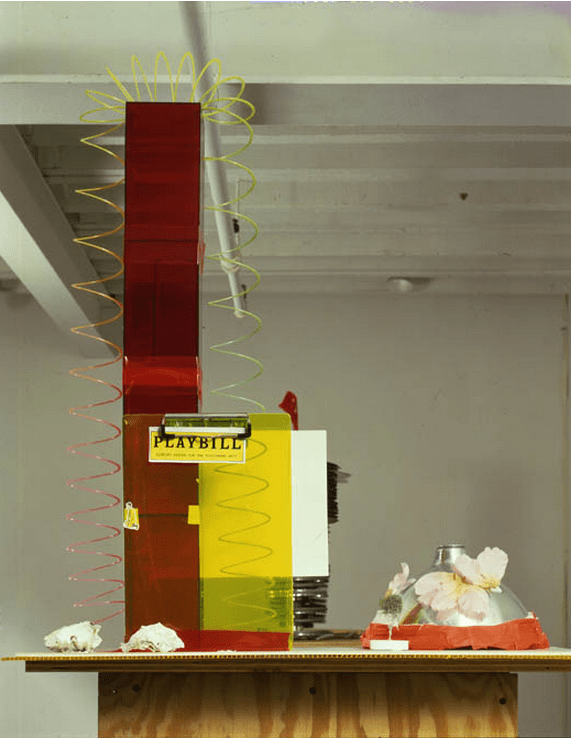Permission To Laugh: Isa Genzken’s Exceedingly Unsmiling Art
Predictably, “Magritte: The Mystery of the Ordinary” (September 28, 2013–January 12, 2014) at the Museum of Modern Art, packed them in.
By Mark Dery

Predictably, “Magritte: The Mystery of the Ordinary” (September 28, 2013–January 12, 2014) at the Museum of Modern Art, packed them in. The day I went, wall-eyed crowds jostled for brief encounters with some of the Belgian Surrealist’s greatest hits — Time Transfixed (the locomotive steaming out of the fireplace), The False Mirror (the giant eye full of blue sky), The Treachery of Images (the pipe bearing the legend “this is not a pipe”) — even though they’d surely seen many of them in reproduction or, more likely, ripped off or riffed on in TV commercials, book jackets, and record covers. Magritte, who did commercial illustration and designed wallpaper before plowing the more lucrative fields of Surrealism, aims for that demographic sweet spot between the bowler-hatted man on the street and the former semiotics major from Brown. More often than not, he nails it. Using a workmanlike realism that is somehow unsettling and reassuringly familiar at the same time (the unheimlich strikes again!), he speaks directly to the visual unconscious. Enthralled, the crowds press close, listening with their eyes.
Meanwhile, in a nearby gallery, a trickle of glum viewers force-marched themselves through the desultory rubbish-heaps of a retrospective devoted to the German artist Isa Genzken—grungy, dispirited installations and assemblages suffering from a debilitating post conceptualist hangover. Those of us who count ourselves (happily!) among Roland Barthes’s impassioned amateurs, yet have just enough art history and critical theory under our belts to be dangerous; who consider ourselves politically and culturally progressive and, after that third martini, perhaps even radical; who rolled a pitying eye at Tom Wolfe’s rearguard battle against modernism in The Painted Word and Hilton Kramer’s fulminations against postmodernism in The New Criterion — even we can’t suppress the thought that nags at us all through “Isa Genzken: Retrospective”: that Kramer was onto something when he lambasted the Whitney Biennials for their “positive hostility toward—a really visceral distaste for—anything that might conceivably engage the eye in a significant or pleasurable visual experience.” (You’re thinking that Kramer was a high-modernist reactionary, given to Da Vinci Code crackpottery about the cabal of Leftists that controls the artworld. Point taken. But scripture can cite the Devil to serve its purpose.)

He’s wide of the mark when he suggests that art must be visually “pleasurable” but dead-on when he makes what should be a relatively uncontroversial point, namely, that visual art, whatever else it is, is visual. To restate the obvious: art is a beheld thing; anything it has to say should be addressed to the eye. That’s not to say that art is a brain-dead discourse whose pleasures are purely retinal, and thus anti-intellectual. But it is to say that any work of art that takes shape outside the artist’s mind, in material form, must “engage the eye.” Even when the artist’s interest lies primarily in the idea, as it does in, say, Duchamp’s Fountain or Rauschenberg’s Erased de Kooning, it is still the thing itself — the inescapable fact of the idea’s embodiment—that meets the eye, and must therefore be reckoned with, critically. Obviously, there’s a place for post-Duchampian artworks that consist of nothing but ideas, expressed in writing; that’s why God, in the bearded, Old Testament guise of Lawrence Weiner, gave us conceptual art, which must be judged on its intellectual (and, be it said, literary) merits. But work such as Genzken’s, which tries to split the difference between the jouissance of dumpster-diving and the austerity of conceptual art, must still engage the eye, pleasing it or poking it, whichever works. Genzken’s art is too indifferent to its materials to do either. Rauschenberg got there first, with Monogram (1955-59), the taxidermied goat with the rubber tire around its middle and a splash of paint on its nose for comic effect, and said it better, and had a lot more fun saying it.
Oddly, the New York Times critic Roberta Smith sees “raw, unapologetic beauty” in Genzken’s Weltempfänger [World Receiver] (1987–89), concrete blocks fitted with radio antennas. Why cinderblock accessorized with antennas? None but the brick-thick dare ask. If you must, the press kit is here to help: they “imbue forms with narrative content through a minimum of means.” Over there, those blown-up ads for high-end stereo systems? They’re appropriations, of course — 65 years after Duchamp called a bottle rack art, but who’s counting? — at once “a celebration of the increasing perfection of commodity objects and a comment on their fetishization by the popular media” because why take a stand when you can split the difference between celebration and critique, revelry and irony, leaving no flank exposed? This is Adorno for undergrads; Frankfurt Marxism Lite.
Elsewhere in the show is an installation titled Der Amerikanische Raum [The American Room] (2004), a diorama of an executive’s office that is, of course, a trenchant meditation “on the theme of American power” and, oh, what the hell, nationalism, globalism, and consumerism, too, as long as we’re stuffing our blunderbusses with ideological buckshot. Tacky plastic figurines of a bald eagle, plunked on a plinth, and Scrooge McDuck with a fistful of bills, on an executive’s desk—mascots of Team America, global hegemon—pound home the point for those of us who missed Ariel Dorfman’s How to Read Donald Duck: Imperialist Ideology in the Disney Comic the first time around, in 1984.

Ironically, given some critics’ derisory portrayal of Magritte as a self-plagiarizing, merchandising-crazy hack, Genzken emerges as the more calculating careerist. Her work makes Political and Ideological Statements in that bankably strident yet maddeningly noncommittal way that flatters the art world’s sense of itself as still edgy after all these years. Case in point: Da Vinci (2003), a few chunks of airplane fuselage with windows, the last of which is splashed with a multicolored drizzle of paint, evocative of a blood-spatter pattern, nameless horror, or whatever. It is, we’re told, a trenchant comment on 9/11. The Gallerist critic at The New York Observer judges it “terrific and terrifying in the wake of 9/11.” Your narrator judges it griefsploitation of the worst kind, the sort of shameless, muzzy-minded attempt to be topical we’d expect from the most gong-able contestant on Work of Art: The Next Great Artist.
Speaking of Political and Ideological Statements, Genzken is reputed to have allowed a member of the notorious Baader-Meinhof gang to use her passport, back in the day, a rumor (duly noted in the Wall Street Journal and The New Yorker) that adds a whiff of radical chic to an artist who wears Dior to her Times interview and says, of her triumphal visit to New York on the occasion of the MoMA show, “Everybody is coming to see me. The other night at dinner, Cindy Sherman came and she was very nice to me. I quite enjoyed it.”

It’s always nice when people are nice. It’s especially nice when they overlook your work’s glaring weaknesses, aesthetic and conceptual, and give you a feminist freebie just for being female. “Isa Genzken and Women Artists: Defying the Boys’ Club,” blared a BBC headline, trumpeting a story that commendably took the artworld to task for its sexism but neglected to note that it was MoMA, not the artist, that was doing the defying by green-lighting Genzken’s retrospective. Likewise, Smith’s insistence that the show constitutes “a disturbance in the force of the New York art world” because it “counters the season’s trend of big retrospectives devoted to male artists and increases from a paltry four to a still paltry five the number of full-dress sixth-floor retrospectives the Modern has bestowed upon women since taking back its expanded building nine years ago” leaves the reader with the impression that the artist has dealt the patriarchy an almighty whack in the nads whereas, again, it’s the Modern that has, at last, Done the Right Thing. Too little, too late, to be sure, but here’s hoping this is the beginning of a trend, one that gives more, and far worthier, women the marquee treatment at New York museums. Bonus points for the occasional artist of color.
We can deplore the sexism of the artworld, as the culture-jamming feminist activists Guerrilla Girls have done so wittily, and we can applaud the MoMA curators who, just this once, flouted the unwritten rule that career retrospectives must go to the pale, the male, and the stale, but it doesn’t logically follow that we must fawn over an artist simply because she’s a woman. If feminism means anything, it means regarding women as handily men’s equal, which in this instance means contemplating a female artist’s work with the same critical rigor we’d bring to bear on a man’s. The tendency, in some quarters, to banish to the cultural gulag any “hater” (though especially male critics) who has the temerity to file a minority report on a female artist, especially one whose female fans perceive her, rightly or wrongly, as feminist—Lady Gaga, Marina Abramović, Amanda Palmer, Lena Dunham, whoever — is the merest Stalinism.

Ironically, Genzken is dedicated to the high-modernist proposition, straight out of Clement Greenberg’s 1939 essay, “Avant-Garde and Kitsch,” that impenetrability and profundity are joined at the hip. If the booboisie don’t get it, so much the better: “I think my work is very difficult to understand. Sometimes people do and sometimes they don’t. I can’t do much about that.” Smith intervenes, explaining that Genzken’s slapdash assemblages—uncannily reminiscent, en masse, of the living-room landfills in Hoarding: Buried Alive — are heady stuff, art that “decimates taste and frequently looks nothing like art,” a statement that must’ve made the artist’s face light up when she read it — or would have, if cracking a smile didn’t risk reducing her granitic self-importance to rubble. In her interviews, Genzken comes off as the exceedingly unsmiling type, as befits her enfant terrible status and the stone-faced humorlessness of her work.
Randy Kennedy demurs. In a New York Times profile titled “No, It Isn’t Supposed to Be Easy,” he finds her “menacingly funny.” Hilarity ensues when Kennedy asks when she first realized she was destined to become an artist: “It was very, very early, if I remember correctly,” quips Genzken, “when I was still in the body of my mother,” a zinger that made them ROTFLTFAO at the Friars’ Roast. It either puts to rest the perception that the artist and her art kill humor dead on contact or confirms Simon Critchley’s unkind cut, in his study On Humour, that “German humor is no laughing matter.”
In the MoMA promo video, This is Isa Genzken, the conceptual artist Dan Graham calls Genzken’s work “deeply humorous,” “a break with high seriousness” that is in step with “a whole generation of artists, like Mike Kelley and Jim Shaw, whose work tries to break with high seriousness in conceptual art.”
Early in the short film, Lawrence Weiner insists that Genzken’s art “doesn’t have anything to do with her nationality,” but the remarks of two younger artists featured in the film give the lie to that assertion. “She’s part of a generation of German artists who refuse to become dogmatic and didactic, and that is the political act in the work,” says Liam Gillick. Wolfgang Tillmans, who is German, adds, “What Isa really doesn’t like is uptightness, is squareness.” Maybe her work does look “deeply humorous” in the context, not just of conceptual art (which is dour enough, embodied by the Heston-as-Moses portentousness of Lawrence Weiner), but specifically in the context of the German reputation—fair or not—for humorlessness, a national trait caricatured in the heel-clicking Junkers and twitchy Teutomatons who proliferate in pop culture, from the New Wave androids on Saturday Night Live’s “Sprockets” to the YouTube détournement of Hitler’s grand-mal rant in the movie Downfall to the gonzo critic Lester Bangs’s unforgettable encounter with the robotic members of Kraftwerk:
I wondered aloud if they would like to see it get to the point of electrodes in the brain so that whatever they thought would come through a loudspeaker.
“Yes,” enthused Ralf, “this would be fantastic.”
The final solution to the music problem, I suggested.
“No, not the solution. The next step.”
Genzken, who was born in ’48, grew up amid the psychic ruins of Hitler’s Gotterdammerung — almost literally: in 1960, she and her family inherited the Berlin villa of her grandfather, Karl Genzken, described in a recent Der Spiegel profile of the artist as “a Nazi through and through, a doctor who…headed the medical office of the so-called ‘Death’s Head’ unit of the SS, which ran the concentration camps…” He oversaw experiments on prisoners involving poison gas and tuberculosis, as well as the forced sterilization of inmates. At Nuremberg, Karl Genzken was sentenced to life in prison but was released after a few years. According to Der Spiegel, the artist once “hinted” that she visited her grandfather in Landsberg Prison in Bavaria (where Hitler, in happier days for the grand old party, had written Mein Kampf).
The artist doesn’t like to talk about her childhood. Even so, one of the her videos chronicles “a visit with her grandparents in the Bavarian woods,” says Kaspar König, a curator interviewed in the MoMA video. “You can tell what it means to grow up in post-Nazi Germany, and be confronted with memories and insist on knowing what your parents did; it’s very tragic.” Oddly, the MoMA press materials make no overt mention of the proximity of the Nazi past in the artist’s life, dodging the question of whether it may have influenced her work — a sin of omission I’m not the first to find curious: Tablet, the journal of Jewish cultural commentary, recently ran an article titled, “MoMa Catalog Omits Artist’s Nazi Grandfather: Should Isa Genzken’s exhibit material make the connection?”
Learning, belatedly, of her grandfather’s role in Germany’s historical nightmares puts an odd, wobbling spin on my memories of the show. So, too, does catching that unexplained glimpse of her, in one of the shaky, homemade videos excerpted in the MoMA film, in what appears to be a parody of a Nazi officer’s uniform, complete with high-prowed cap. Looking back on Genzken’s raw, concrete sculptures, evocative of architectural maquettes for Brutalist buildings, I can’t help seeing them, now, as allusions to Speer’s “ruins doctrine,” the aesthetic principle that Nazi architecture should be built to look sublime in picturesque decay, a thousand years from now. With poetic justice, Speer’s hulking kitsch ended up as ugly rubble and twisted rebar.
I’m not suggesting there’s a fascist subtext to Genzken’s work, merely that the long shadow of Germany’s past stretches across it, and might have something to do with its humor, or lack of it, a question whose cultural politics interest me. Certainly, restoring that lost context drags her work out of the hothouse self-referentiality of artworld discourse, which can only see it as a reaction of the “high seriousness” of the conceptual tradition, and relocates it in history, both personal and national, in a way that makes it more interesting intellectually, if not visually.
The critic Gregory H. Williams writes, with audible trepidation, that of all the artists he discusses in Permission to Laugh: Humor and Politics in Contemporary German Art — a title that is, in its own way, a punchline — “Genzken is surely the least obvious choice for a study of art and humor.” That sound you hear is the entire art world waiting, with bated breath, for the rubber chicken to drop. ![]()
(Thanks to the cultural theorist Thyrza Nichols Goodeve for her perceptive critique of an early draft of this essay.)




